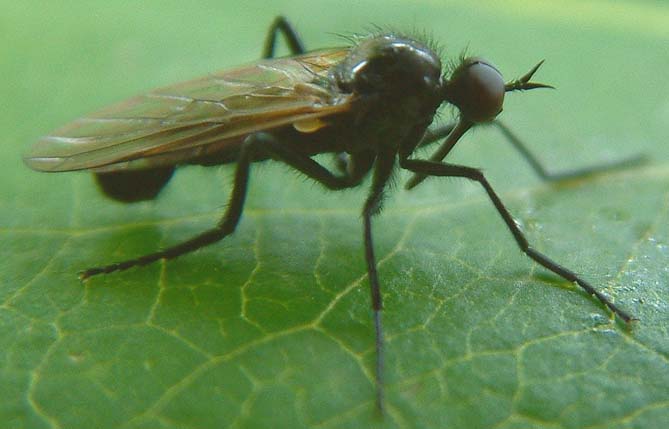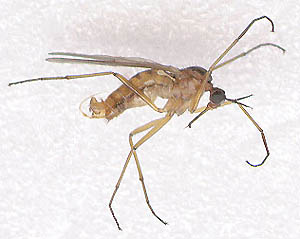
BUG OF THE MONTH: April 2004
Empis Dance Flies
Empis spp.
Order Diptera, Family Empididae
Copyright © 2004 by Dave Pehling
This article originally appeared in Scarabogram, April 2004, New Series No. 288, p. 2.
Dipterists in Washington have the opportunity to meet a fascinating little fly that is often found around wooded creeks during the spring. I originally became interested in this family when I was asked to key out an odd-looking beaked specimen. Most of the following is taken from the "Dipterist's Bible," Flies of Western North America by Frank Cole.
 |
| Empis lucida, photographed in Iceland. © Johannes Skaftason |
This family contains more than 1600 described species, with the genus Empis containing about 460 species. [The North American Diptera Catalog lists 87 Empis species in the USA and Canada. Those known or likely to occur in Washington include E. aeripes, aldrichii, barbatoides, canaster, laniventris, poplitea and virgata.]
 |
| Empis livida female, Berkshire, UK © Malcolm Storey |
 |
| Empis trigramma male, Berkshire, UK © Malcolm Storey |
The head is more or less spherical, with a visible neck; eyes large, often restricting the face. Proboscis well developed and rigid, and often wielded with abandon by these little predators.
Several of the Empis species are "balloon makers." That is, the male flies capture an insect and enclose it in a frothy bag. The male carries this package around with him as a lure to entice the female to mate. (Females of many species seem to require something of this sort. Wonder if a "bug balloon" would work with H. sapiens?) Some species dispense with the froth. Empis barbatoides males capture little insects, usually weaker flies like bibionids (March flies), and dangle them in front of females as a preface to courtship. Others trick their intended with an empty ball of silk.
[Larvae, according to the Diptera Catalog, are "usually found in rich, moist soil." According to Cole, "We know very little about the early stages of these flies. The larvae (of all empidids, not just Empis) have been found in decaying vegetable matter and in aquatic associations, or under the bark of trees."]
If you wish to observe/collect these little flies ("big" species are 9-10 mm), look for them in swarms under trees and about small streams where they wheel around in their mating flights (Empis poplitea swarms in May in western Oregon). They exhibit a preference for moist areas, but are found in nearly all types of habitats and at nearly all elevations. Many species are best collected on tree trunks by placing the mouth of a killing jar over them or by using a suction device. Other species are supposed to occur in large numbers on flowers such as currants, stone-fruits, Oregon grape, etc.
On our warmest day in late April [2000], I took a short walk in the woods to see what was up (or down, as the case may be). Walking among the blossoming salmonberries and wild lily of the valley, I was amazed to see the mating activity of a pair of Empis. The male had presented his chosen partner with a juicy gift (an unfortunate male March fly, family Bibionidae) upon which the female was feasting while he had his way with her. I rushed to the house to grab my camera, set up the close-up lens, adjusted the flash, and ran back to the woods. Just as I was bringing my prey into focus, a scurrying soldier beetle (family Cantharidae) ran down the twig and startled the couple, causing them to drop off into the thick vegetation. So much for that!
References
Roy Beckemeyer's Empid Page
http://www.windsofkansas.com/empid.html
Cole, Frank R. 1969. The flies of western North America. University of California Press, 693 pp. P. 255, 263-4.
Stone, Alan, et al. 1983 [reprint of 1965 version]. A catalog of the Diptera of America north of Mexico. Smithsonian Institution Press, 1696 pp. Empis on pp. 457-461.
This page last updated 26 July, 2005